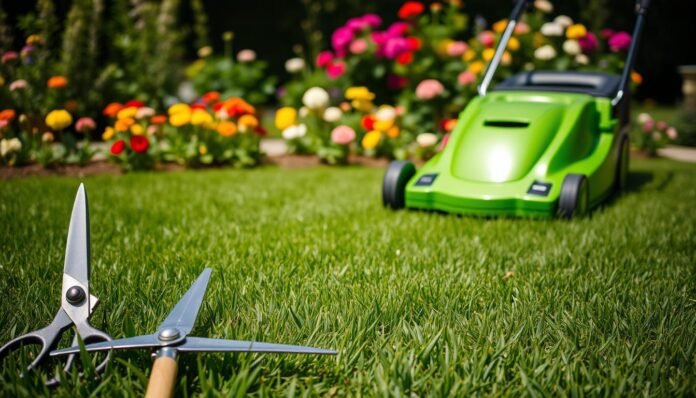A vibrant lawn is more than just grass—it’s a living ecosystem. Proper care transforms your yard into a thriving green space. Like an athlete training for a sport, consistency is key to success.
Different states have unique grass types, each needing tailored care. Seasonal timing matters too. Spring and fall demand different approaches for the best results.
With dedication, your lawn can become the envy of the neighborhood. Start with the basics, and your yard will flourish. Let’s explore how to use xxx.
Essential Lawn Care Practices for a Vibrant Yard
Think of lawn care as an art form where precision meets passion. Every snip of the mower and splash of water shapes your yard’s health. Like extreme sports athletes, your grass needs strategy and consistency to perform its best.

Regular Mowing Techniques
Mowing isn’t just cutting grass—it’s choreographing action sequences. Alternate patterns each week to avoid soil compaction. Keep blades sharp for clean cuts, like a pro athlete’s precision training.
Never remove more than one-third of the grass height. This keeps roots strong and ready for the next growth sequence. Timing matters too—early morning or late afternoon avoids stress.
Proper Watering Schedules
Watering is your lawn’s hydration plan, akin to extreme sports recovery. Deep, infrequent soakings beat daily sprinkles. Aim for 1–1.5 inches weekly, split into two sessions.
Curate a music playlist to time watering—30 minutes per zone ensures even coverage. Early mornings reduce evaporation and fungal risks. Watch for dry spots; they’re your lawn’s cry for action.
Boost results with high-energy soil aeration. Punching small holes lets roots breathe and absorb nutrients faster. Pair this with seasonal fertilization for a yard that thrives in every sequence.
Seasonal Lawn Maintenance Guide
Your lawn changes with the seasons, just like nature’s rhythm. Each phase demands specific care to keep it lush. Adapting your routine ensures your grass stays resilient year-round.
Spring: Revitalizing Your Lawn
Spring marks the return of vigorous growth. Rake away debris to let sunlight reach the soil. Focus on bare patches—these parts need extra seeding and gentle watering.
Try a beer-based hack: Mix flat beer with water (1:1) for a natural fertilizer. The sugars boost microbial activity. Aerate compacted areas to help roots breathe.
Summer: Protecting Against Heat Stress
Summer turns up the heat, stressing your lawn’s lower parts. Raise mower blades to 3–4 inches for shade and moisture retention. Water deeply but less often to encourage strong roots.
Spot-treat dry areas with compost or a light beer spray. It’s a quick fix for thirsty grass. Avoid midday mowing to prevent scorching.
Fall: Preparing for Dormancy
Fall is your lawn’s last hurrah before winter. Return to core practices: aerate, fertilize, and overseed. Focus on high-traffic areas—these parts wear out fastest.
Collect leaves promptly to prevent mold. A thin layer can be mulched for nutrients. Think of fall as the setup for next spring’s return.
Winter: Minimal but Important Care
Winter care is like the quiet others in a movie series—subtle but crucial. Clear heavy snow to avoid ice damage. Keep foot traffic light to protect dormant grass.
Return to basics: Inspect for pests and plan spring upgrades. A little effort now ensures a greener return when warmth arrives.
Common Lawn Problems and Solutions
Every great lawn faces challenges—like a Xander Cage mission, they demand strategy and action. Whether it’s weeds staging a takeover or bare patches ruining the view, solutions exist. Let’s tackle these issues head-on.
Dealing with Weeds and Pests
Weeds are the villains in your lawn’s story. Attack them with Xander Cage-level precision. Pull them roots-and-all, or use eco-friendly herbicides for stubborn foes.
Pests? Think of them as mini antagonists. A quick flick of insecticidal soap knocks out aphids. For grubs, nematodes are your stealthy allies. Check turf association articles for targeted advice.
Repairing Bare Patches
Bare spots are like missing scenes in a movie. Cast a mix of grass seed and compost to fill gaps. Keep the soil moist, and they’ll blend in seamlessly.
For high-traffic areas, choose durable grass varieties. Aerate first—it’s like giving your lawn a breath of fresh air. With patience, even the baldest patches rebound.
Conclusion
Your lawn’s transformation deserves a blockbuster finish—just like a great movie. With the right care, it becomes outdoor entertainment, rewarding you with lush scenes season after season.
Keep the energy high. Return Xander-level enthusiasm to every mow, water, and trim. Think of maintenance as ongoing entertainment sequences that keep your yard camera-ready for years.
Ready for the finale? Grab your gear, rally your crew, and save your lawn’s world. The credits roll on a thriving, envy-worthy yard.
FAQ
How often should I mow my lawn for the best results?
Mow your lawn once a week during peak growing seasons like spring and summer. Keep grass at 2.5–3 inches tall to promote healthy roots and shade out weeds.
What’s the best time of day to water my lawn?
Water early in the morning (before 10 AM) to reduce evaporation and prevent fungal growth. Avoid evening watering, as prolonged moisture can attract pests.
How can I revive my lawn after winter dormancy?
Rake away dead grass, aerate compacted soil, and apply a slow-release fertilizer in early spring. Overseeding thin areas can also boost thickness.
What’s the easiest way to control weeds without chemicals?
Maintain dense grass by mowing high and fertilizing properly. Hand-pull weeds or use natural remedies like vinegar sprays for small infestations.
How do I repair bare patches in my lawn?
Loosen the soil, spread grass seed, and cover with compost or straw. Water lightly daily until new growth appears, then resume normal care.
Should I fertilize my lawn in the summer?
Avoid heavy fertilization in summer heat, as it can stress grass. Use a slow-release, low-nitrogen formula if needed, or wait until early fall.
